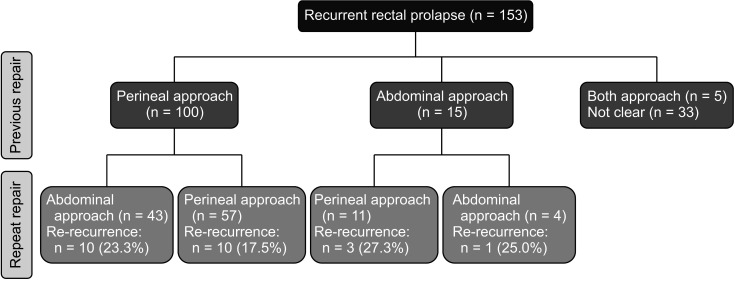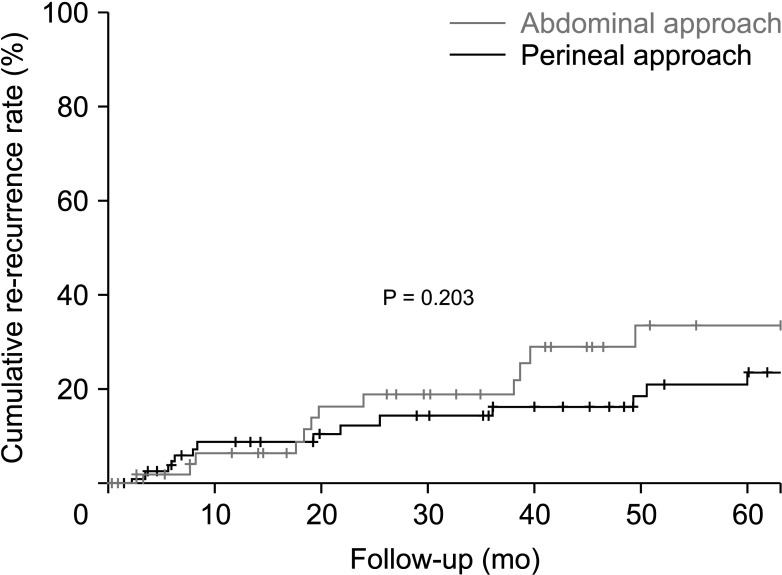Ann Surg Treat Res.
2022 Apr;102(4):234-240. 10.4174/astr.2022.102.4.234.
Clinical outcomes of surgical management for recurrent rectal prolapse: a multicenter retrospective study
- Affiliations
-
- 1Department of Colorectal Surgery, Korea University Ansan Hospital, Ansan, Korea
- 2Department of Colorectal Surgery, Song Do Hospital, Seoul, Korea
- 3Department of Colorectal Surgery, Dae-Hang Hospital, Seoul, Korea
- 4Department of Colorectal Surgery, Korea University Anam Hospital, Seoul, Korea
- 5Department of Colorectal Surgery, Korea University Guro Hospital, Seoul, Korea
- 6Department of Colorectal Surgery, Seoul National University Hospital, Seoul, Korea
- 7Department of Colorectal Surgery, Seoul National University Bundang Hospital, Seongnam, Korea
- 8Department of Colorectal Surgery, Hansol Hospital, Seoul, Korea
- KMID: 2527840
- DOI: http://doi.org/10.4174/astr.2022.102.4.234
Abstract
- Purpose
There are few reports on outcomes following surgical repair of recurrent rectal prolapse. The purpose of this study was to examine surgical outcomes for recurrent rectal prolapse.
Methods
We conducted a multicenter retrospective study of patients who underwent surgery for recurrent rectal prolapse. This study used data collected by the Korean Anorectal Physiology and Pelvic Floor Disorder Study Group.
Results
A total of 166 patients who underwent surgery for recurrent rectal prolapse were registered retrospectively between 2011 and 2016 in 8 referral hospitals. Among them, 153 patients were finally enrolled, excluding 13 patients who were not followed up postoperatively. Median follow-up duration was 40 months (range, 0.2–129.3 months). Methods of surgical repair for recurrent rectal prolapse included perineal approach (n = 96) and abdominal approach (n = 57). Postoperative complications occurred in 16 patients (10.5%). There was no significant difference in complication rate between perineal and abdominal approach groups. While patients who underwent the perineal approach were older and more fragile, patients who underwent the abdominal approach had longer operation time and admission days (P < 0.05). Overall, 29 patients (19.0%) showed re-recurrence after surgery. Among variables, none affected the re-recurrence.
Conclusion
For the recurrent rectal prolapse, the perineal approach is used for the old and fragile patients. The postoperative complications and re-recurrence rate between perineal and abdominal approach were not different significantly. No factor including surgical method affected re-recurrence for recurrent rectal prolapse.
Keyword
Figure
Reference
-
1. Bordeianou L, Hicks CW, Kaiser AM, Alavi K, Sudan R, Wise PE. Rectal prolapse: an overview of clinical features, diagnosis, and patient-specific management strategies. J Gastrointest Surg. 2014; 18:1059–1069. PMID: 24352613.
Article2. Fengler SA, Pearl RK, Prasad ML, Orsay CP, Cintron JR, Hambrick E, et al. Management of recurrent rectal prolapse. Dis Colon Rectum. 1997; 40:832–834. PMID: 9221862.
Article3. Hool GR, Hull TL, Fazio VW. Surgical treatment of recurrent complete rectal prolapse: a thirty-year experience. Dis Colon Rectum. 1997; 40:270–272. PMID: 9118739.4. Steele SR, Goetz LH, Minami S, Madoff RD, Mellgren AF, Parker SC. Management of recurrent rectal prolapse: surgical approach influences outcome. Dis Colon Rectum. 2006; 49:440–445. PMID: 16465585.
Article5. Pikarsky AJ, Joo JS, Wexner SD, Weiss EG, Nogueras JJ, Agachan F, et al. Recurrent rectal prolapse: what is the next good option? Dis Colon Rectum. 2000; 43:1273–1276. PMID: 11005496.6. Tsugawa K, Sue K, Koyanagi N, Hashizume M, Wada H, Tomikawa M, et al. Laparoscopic rectopexy for recurrent rectal prolapse: a safe and simple procedure without a mesh prosthesis. Hepatogastroenterology. 2002; 49:1549–1551. PMID: 12397732.7. Araki Y, Isomoto H, Tsuzi Y, Matsumoto A, Yasunaga M, Yamauchi K, et al. Transsacral rectopexy for recurrent complete rectal prolapse. Surg Today. 1999; 29:970–972. PMID: 10489150.
Article8. Tou S, Brown SR, Malik AI, Nelson RL. Surgery for complete rectal prolapse in adults. Cochrane Database Syst Rev. 2008; (4):CD001758. PMID: 18843623.
Article9. Hotouras A, Ribas Y, Zakeri S, Bhan C, Wexner SD, Chan CL, et al. A systematic review of the literature on the surgical management of recurrent rectal prolapse. Colorectal Dis. 2015; 17:657–664. PMID: 25772797.
Article10. D’Hoore A, Cadoni R, Penninckx F. Long-term outcome of laparoscopic ventral rectopexy for total rectal prolapse. Br J Surg. 2004; 91:1500–1505. PMID: 15499644.
Article11. de Bruijn H, Maeda Y, Tan KN, Jenkins JT, Kennedy RH. Long-term outcome of laparoscopic rectopexy for full-thickness rectal prolapse. Tech Coloproctol. 2019; 23:25–31. PMID: 30604250.
Article12. Senapati A, Gray RG, Middleton LJ, Harding J, Hills RK, Armitage NC, et al. PROSPER: a randomised comparison of surgical treatments for rectal prolapse. Colorectal Dis. 2013; 15:858–868. PMID: 23461778.
Article13. Emile SH, Elbanna H, Youssef M, Thabet W, Omar W, Elshobaky A, et al. Laparoscopic ventral mesh rectopexy vs Delorme’s operation in management of complete rectal prolapse: a prospective randomized study. Colorectal Dis. 2017; 19:50–57. PMID: 27225971.
Article14. Joubert K, Laryea JA. Abdominal approaches to rectal prolapse. Clin Colon Rectal Surg. 2017; 30:57–62. PMID: 28144213.
Article15. Gurland B, E Carvalho ME, Ridgeway B, Paraiso MF, Hull T, Zutshi M. Should we offer ventral rectopexy to patients with recurrent external rectal prolapse? Int J Colorectal Dis. 2017; 32:1561–1567. PMID: 28785819.
Article16. Hyun K, Yang SJ, Lim KY, Lee JK, Yoon SG. Laparoscopic posterolateral rectopexy for the treatment of patients with a full thickness rectal prolapse: experience with 63 patients and short-term outcomes. Ann Coloproctol. 2018; 34:119–124. PMID: 29991200.
Article17. Lundby L, Iversen LH, Buntzen S, Wara P, Høyer K, Laurberg S. Bowel function after laparoscopic posterior sutured rectopexy versus ventral mesh rectopexy for rectal prolapse: a double-blind, randomised single-centre study. Lancet Gastroenterol Hepatol. 2016; 1:291–297. PMID: 28404199.
Article18. Barfield LR. Perineal approaches to rectal prolapse. Clin Colon Rectal Surg. 2017; 30:12–15. PMID: 28144207.
Article19. Elagili F, Gurland B, Liu X, Church J, Ozuner G. Comparing perineal repairs for rectal prolapse: Delorme versus Altemeier. Tech Coloproctol. 2015; 19:521–525. PMID: 26341686.
Article20. Hyun K, Yoon SG. Comparison of Delorme-Thiersch operation outcomes in men and women with rectal prolapse. Ann Coloproctol. 2019; 35:262–267. PMID: 31726002.
Article21. Festen S, van Geloven AA, Gerhards MF. Redo procedure for prolapse and haemorrhoids (PPH) for persistent and recurrent prolapse after PPH. Dig Surg. 2009; 26:418–421. PMID: 19923831.
Article22. Thorlakson RH. A modification of the Thiersch procedure for rectal prolapse using polyester tape. Dis Colon Rectum. 1982; 25:57–58. PMID: 7056143.
Article23. Clavien PA, Barkun J, de Oliveira ML, Vauthey JN, Dindo D, Schulick RD, et al. The Clavien-Dindo classification of surgical complications: five-year experience. Ann Surg. 2009; 250:187–196. PMID: 19638912.24. Ludbrook J, Royse AG. Analysing clinical studies: principles, practice and pitfalls of Kaplan-Meier plots. ANZ J Surg. 2008; 78:204–210. PMID: 18269491.
Article25. Javed MA, Afridi FG, Artioukh DY. What operation for recurrent rectal prolapse after previous Delorme’s procedure?: a practical reality. World J Gastrointest Surg. 2016; 8:508–512. PMID: 27462393.
Article26. Warwick AM, Zimmermann E, Boorman PA, Smart NJ, Gee AS. Recurrence rate after Delorme’s procedure with simultaneous placement of a Thiersch suture. Ann R Coll Surg Engl. 2016; 98:419–421. PMID: 27092405.
Article27. Ding JH, Canedo J, Lee SH, Kalaskar SN, Rosen L, Wexner SD. Perineal rectosigmoidectomy for primary and recurrent rectal prolapse: are the results comparable the second time? Dis Colon Rectum. 2012; 55:666–670. PMID: 22595846.
- Full Text Links
- Actions
-
Cited
- CITED
-
- Close
- Share
- Similar articles
-
- Comparison of abdominal and perineal approach for recurrent rectal prolapse
- Surgical Treatment of Rectal Prolapse: A 10-Year Experience at a Single Institution
- Changing Trend of Rectal Prolapse Surgery in the Era of the Minimally Invasive Surgery
- Complete Rectal Prolapse Combined with Rectal Cancer: A Case Report
- Neorectal Mucosal Prolapse After Intersphincteric Resection for Low-Lying Rectal Cancer: A Case Report



